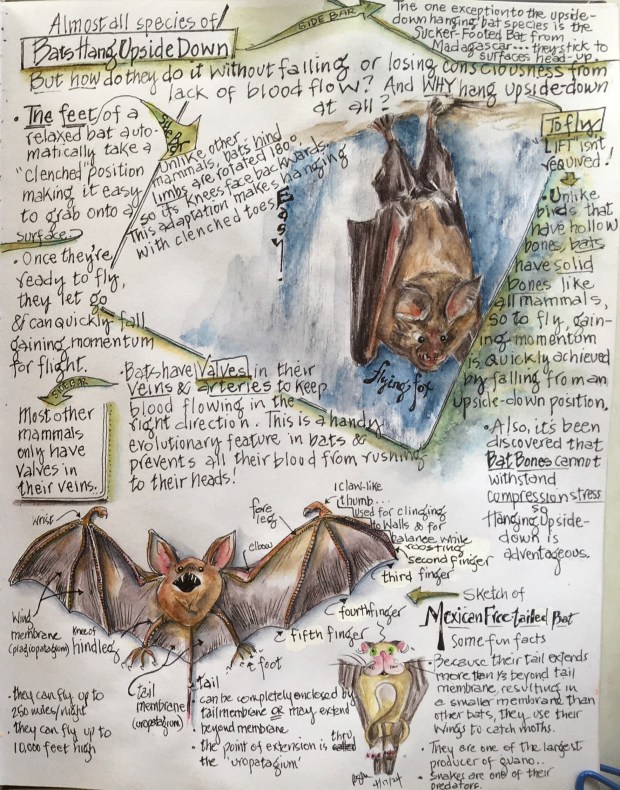April 19, 2024
Of the dozen or so celebrations taking place annually on April 17th, you might think that combing both National Bat Appreciation Day and National Haiku Poetry Day in one blog post makes no sense at all. But if you’ve ever spent even a bit of time witnessing a bat ‘out flight’ at dusk, you’d agree with me that their near-silent hunting maneuvers are sheer poetry!
National Bat Appreciation Day
A holiday celebrated each year to promote awareness about bats and their importance in maintaining healthy ecosystems.
National Haiku Poetry Day
An annual celebration to honor and promote the cultural significance of Haiku, a Japanese form of poetry.
Dedication
This post is dedicated to my good friend, Holly Silva, who finds bats fascinating. She suggested for my first celebratory day in April, I tackle bats. (Not literally of course!) Like Holly, I’ve always been in awe of bats, having seen many ‘out-flights’ of the tiny insectivorous myotis bat and little brow bat. And then there’s fruit bats! Oh my …… so hard to resist sharing my story of an amazing fruit bat ‘out flight’ Roy & I witnessed in the Australian Outback, Bats in OZ!
Bats in OZ
Talk about right place/right time scenario! We had finally arrived at a well known hot springs south of Katherine after a long, hot, dry day through central Australia. Mataranka, a beautiful series of natural pools surrounded by hundreds of eucalyptus (gum) trees. It was late in the day and we were luxuriating in the hot water, when we noticed everyone there before us was leaving. It was a mass exodus; suddenly we had the springs to ourselves. Five minutes later that we noticed the water rippling around us. We figured a freak storm had appeared out of nowhere to offload huge raindrops in just this spot. Then the “rain” became more intense, the noise became cacophonous, and day turned into night.
When we first arrived at Mataranka, our focus was on the inviting pools of water nicely shaded by the gum trees. We never looked up into any of those tall, branchy trees … we were happy to have the shade. Now, soaking in the hot water while getting pelted by “rain,” we wondered if we should haul ourselves out, recalling that the locals must’ve known this storm was about to happen (as it did every night); maybe it wasn’t safe for some reason? So wondering how big the storm cloud was we glanced up at the sky through the tree branches. That’s when shock and awe grabbed us! Hundreds and hundreds of tree branches which must’ve been straining under a great weight minutes ago were sighing relief as thousands of fruit bats (aka flying foxes) dropped from their roosts to take flight. Wing membranes spread wide, their sheer numbers blocked out the fading sun. We were speechless! Gaping in awe at the spectacle, our mouths quickly snapped shut …… you see, that “downpour” wasn’t rain at all! All of those big, beautiful bats were pooping out guano as fast as they could! Another ah-ha moment struck us (along with copious quantities of guano) as we made a hasty retreat out of the water, grabbing our clothes and sun hats, and laughing uproariously while beating feat back to the safety and cover of the rental car!
As fast as the “storm” of bats appeared, they were gone, flying off to feed for the night on a Downunder spring bounty of fruits only they knew about. Stuffed by sunrise they would return to the Mataranka community roost to rest and digest before once again taking flight while pooping on the heads of foolish tourists tomorrow at dusk!
The Post
For this post, while exploring bats’ importance in the ecosystem, to science, and while recalling all of those Australian flying foxes I was curious about why and how bats hang upside down, the types of bats and their diets, and what adaptations Vampire bats have causing them to crave a diet of blood. Much of this rabbit-trailing led to myths and misconceptions about bats, then back to New Mexico’s most famous ‘out flight’ of the American Free-tailed Bat every spring, summer and fall evening from Carlsbad Caverns. While learning, several Haiku poems materialized reflecting bat behavior.
Nighttime brings darkness
A near silent “whoosh” above
Bats! Winged wonders hunt
It would’ve been easy and fun to fill up the rest of my journal with bat facts and more Haiku, but because the celebratory date of both National Bat Appreciation Day and National Haiku Poetry Day has now come and gone, I had to stop. Maybe you’ll want to answer a bunch of your own questions about bats? Maybe you’ll want to write your own Haiku about bats in honor of this style of poetry?
Mosquitoes beware!
Cauldron of bats overhead ….
Echolocation!
Share your bat stories and Haiku, and let me know if this inspires you to dig deeper into the fascinating world of bats!































